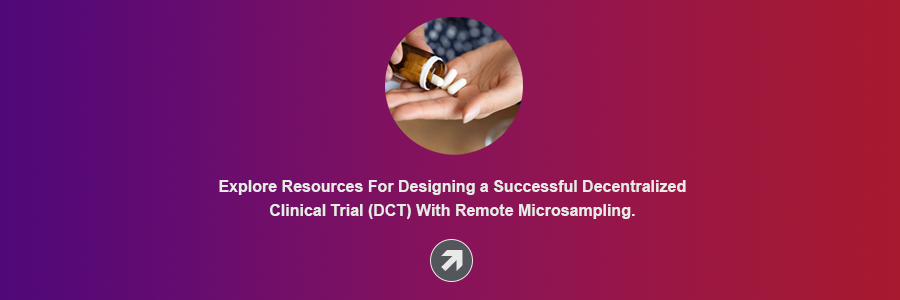Share this
fast, accurate clinical trial monitoring with remote sampling
by Neoteryx Microsampling on Mar 31, 2020 10:00:00 AM
Clinical trial monitoring is an essential process of drug development. It is the stage where developed drugs are tested on human subjects to determine if they are effective.

To get to this point, subjects for the trial must be recruited and trained. During the training period, subjects are informed about what to do and avoid during the clinical trial period. Subjects are under constant monitoring that involves testing various elements of their bodies. This includes but is not limited to blood, urine, stool, and/or saliva. Trials that require frequent blood-drawing can be inconvenient and may put the subject’s health at risk.
Due to the amount of time and money that goes into clinical trial monitoring, scientists develop a clinical trial monitoring plan that maps the entire process. Monitoring subjects in clinical trials also ensures the trials are conducted, recorded, and reported according to established plans and guidelines.
On-site monitoring is conducted to ensure the subjects’ rights and well-being are protected, the data presented is accurate, and the entire process is compliant with regulatory requirements.
Because of subject retention issues, it’s vital to make clinical trials smoother for both the scientists and the test subjects. With microsampling, clinical trial monitoring is easier. Some trials don’t need subjects on-site. With remote sampling as an option, the clinical trial monitoring process becomes easier, faster, and less costly.
Remote Sampling and Remote Clinical Monitoring: How It Works
Remote sampling is a process in which subjects take specimen samples at home, then send them to the test centers. Minimal interruptions in subjects’ lifestyles have resulted in lower subject dropouts and more diligent adherence to sponsor protocols. The cost of clinical trials decrease because:
- Cost of travel for subjects is reduced
- The heavy investment going into clinical trial-site audit is no longer needed
- There are different types of monitoring visits in clinical trials for every test subject; remote sampling reduces the number of on-site monitoring visits
Remote sampling has made the clinical trial process faster, more accurate, and more cost-effective. With additional advancements in remote technology, we can anticipate greater strides forward for virtual clinical trials and telemedicine.
Share this
- Microsampling (206)
- Research, Remote Research (119)
- Venipuncture Alternative (105)
- Clinical Trials, Clinical Research (83)
- Mitra® Device (73)
- Therapeutic Drug Monitoring, TDM (51)
- Dried Blood Spot, DBS (39)
- Biomonitoring, Health, Wellness (30)
- Infectious Disease, Vaccines, COVID-19 (24)
- Blood Microsampling, Serology (23)
- Omics, Multi-Omics (21)
- Decentralized Clinical Trial (DCT) (20)
- Specimen Collection (18)
- Toxicology, Doping, Drug/Alcohol Monitoring, PEth (17)
- Skin Microsampling, Microbiopsy (14)
- hemaPEN® Device (13)
- Preclinical Research, Animal Studies (12)
- Pharmaceuticals, Drug Development (9)
- Harpera Device (7)
- Industry News, Microsampling News (5)
- Antibodies, MAbs (3)
- Company Press Release, Product Press Release (3)
- Environmental Toxins, Exposures (1)
- July 2025 (1)
- May 2025 (1)
- April 2025 (2)
- December 2024 (2)
- November 2024 (1)
- October 2024 (3)
- September 2024 (1)
- June 2024 (1)
- May 2024 (1)
- April 2024 (4)
- March 2024 (1)
- February 2024 (2)
- January 2024 (4)
- December 2023 (3)
- November 2023 (3)
- October 2023 (3)
- September 2023 (3)
- July 2023 (3)
- June 2023 (2)
- April 2023 (2)
- March 2023 (2)
- February 2023 (2)
- January 2023 (3)
- December 2022 (2)
- November 2022 (3)
- October 2022 (4)
- September 2022 (3)
- August 2022 (5)
- July 2022 (2)
- June 2022 (2)
- May 2022 (4)
- April 2022 (3)
- March 2022 (3)
- February 2022 (4)
- January 2022 (5)
- December 2021 (3)
- November 2021 (5)
- October 2021 (3)
- September 2021 (3)
- August 2021 (4)
- July 2021 (4)
- June 2021 (4)
- May 2021 (4)
- April 2021 (3)
- March 2021 (5)
- February 2021 (4)
- January 2021 (4)
- December 2020 (3)
- November 2020 (5)
- October 2020 (4)
- September 2020 (3)
- August 2020 (3)
- July 2020 (6)
- June 2020 (4)
- May 2020 (4)
- April 2020 (3)
- March 2020 (6)
- February 2020 (3)
- January 2020 (4)
- December 2019 (5)
- November 2019 (4)
- October 2019 (2)
- September 2019 (4)
- August 2019 (4)
- July 2019 (3)
- June 2019 (7)
- May 2019 (6)
- April 2019 (5)
- March 2019 (6)
- February 2019 (5)
- January 2019 (8)
- December 2018 (3)
- November 2018 (4)
- October 2018 (7)
- September 2018 (6)
- August 2018 (5)
- July 2018 (8)
- June 2018 (6)
- May 2018 (5)
- April 2018 (6)
- March 2018 (4)
- February 2018 (6)
- January 2018 (4)
- December 2017 (2)
- November 2017 (3)
- October 2017 (2)
- September 2017 (4)
- August 2017 (2)
- July 2017 (4)
- June 2017 (5)
- May 2017 (6)
- April 2017 (6)
- March 2017 (5)
- February 2017 (4)
- January 2017 (1)
- July 2016 (3)
- May 2016 (1)
- April 2016 (2)



Comments (1)